
A discussion of furniture design trends that also examines the
relationship between form,
function and what consumers will
be looking for to meet their home furnishings needs
as we exit the
pandemic.
For this installment of the Design & Designer series, Furniture World interviewed SCAD (Savannah College of Art and Design) professor Sheila Edwards and Fred Spector, SCAD’s Associate Chair of Furniture Design. Spector is also the founder of Frederic Spector Design Studio, a design firm specializing in commercial and residential furniture, lighting and tabletop products. Spector did his graduate work in industrial design at the Rhode Island School of Design and studied furniture design at University of the Arts in Philadelphia. He interacts with students in a number of ways. As well as teaching studio design classes, Spector is responsible for teaching a professional practice class for graduating seniors. “It covers everything from creating a portfolio to understanding the business side of being a freelance furniture designer,” he explained.
Sheila Edwards took a more adventurous path to become a furniture design professor. She worked in the field of psychology for several years after graduating from Marquette University in Milwaukee. “And then,” she recalled, “I spent several years working in New Mexico’s public school system, then in Alaska’s fisheries, took a job as a photographer’s assistant and held several other positions before discovering a calling to pursue art and design as a career.
"I attended Haystack Mountain School of Crafts, took a class there with Jo Stone, a fantastic furniture maker and teacher. She opened my eyes to the potential of furniture as an object that can shape social behavior and provide support for the best parts of people’s lives. At that point, I returned home to Cleveland, worked as a carpenter’s apprentice, attended SCAD for graduate school, became a custom metal fabricator, returned to SCAD, and ended up teaching a course in furniture design. I’m particularly interested in the relationship between humans and functional objects as well as how people develop and assign meaning to those objects according to function; physical, social and emotional."
Students from a number of disciplines at SCAD participate in Sheila Edwards' furniture history course. “We have students from furniture design, but also industrial design, architecture, interior design, game development and film production design. It's very collaborative."
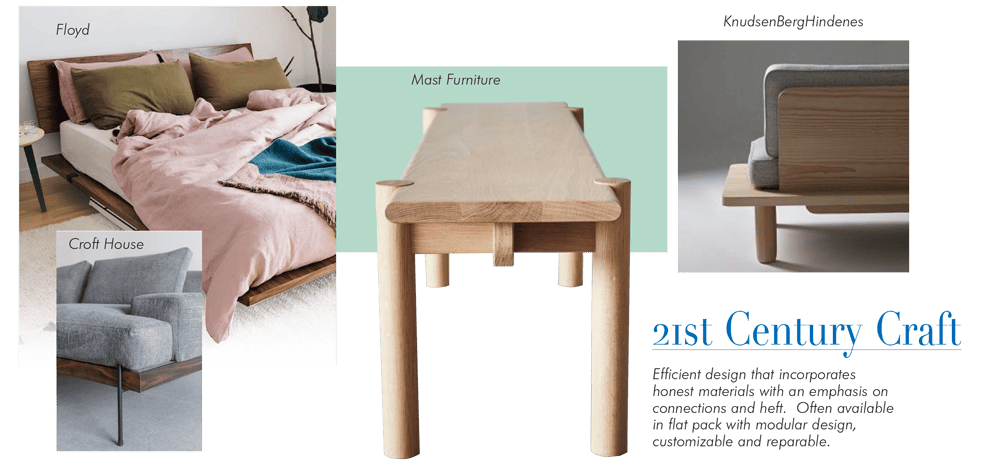
Industry Trend Spotting
Furniture World asked if she thinks the topics covered in her furniture design course at SCAD are of use to home furnishings retailers.
“Certainly,” she replied. “History operates in cycles. So, if retailers and manufacturers can correctly identify why certain styles, materials, shapes and colors are trending, they may be able to anticipate what’s coming next.
“We find ourselves in a moment that’s multi-faceted with numerous trends happening all at the same time. It is the style of the individual in many ways, but certain themes are emerging. Understanding the cycles of history can help brands and retailers tell a story that resonates with their customers. And since today’s consumers prefer to ‘buy’ a story along with their furniture, being able to relate historical and design information becomes meaningful from a sales perspective.”
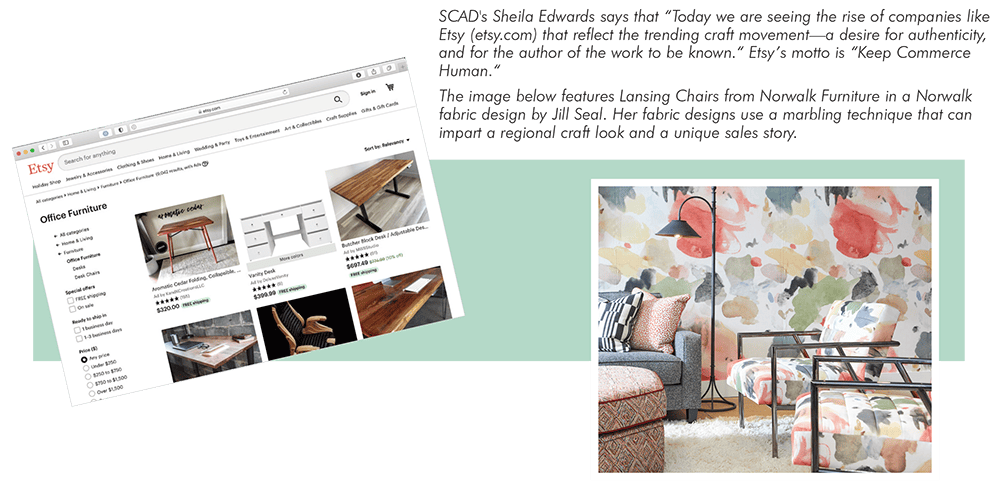
Trend: Neotenic Design
“Neotenic design is trending,” Edwards continued. “The term Neoteny refers to large rounded features present in young animals. We’re seeing cute, sort of chubby furniture incorporating larger shapes and forms.
“This trend might be a reaction to the high level of stress and anxiety present in society over the past several years. I recall seeing mushroom and pill-shaped designs at the Milan show in 2013. During the pandemic, we’re seeing those forms become more mainstream, with soft colors, peachy pinks and muted rust—earthy colors.”
“Neotenic design isn’t trending in the mass market yet,” elaborated Fred Spector, “but it can be seen in the European market and is present among smaller boutique furnishings manufacturers who’ve introduced soft, rounded, voluptuous and even childlike forms.
“We’ve seen a similar trend for a while now in outdoor furniture with big, heavy, pillowy cushions that envelope the sitter. Several companies have done well with that look.”
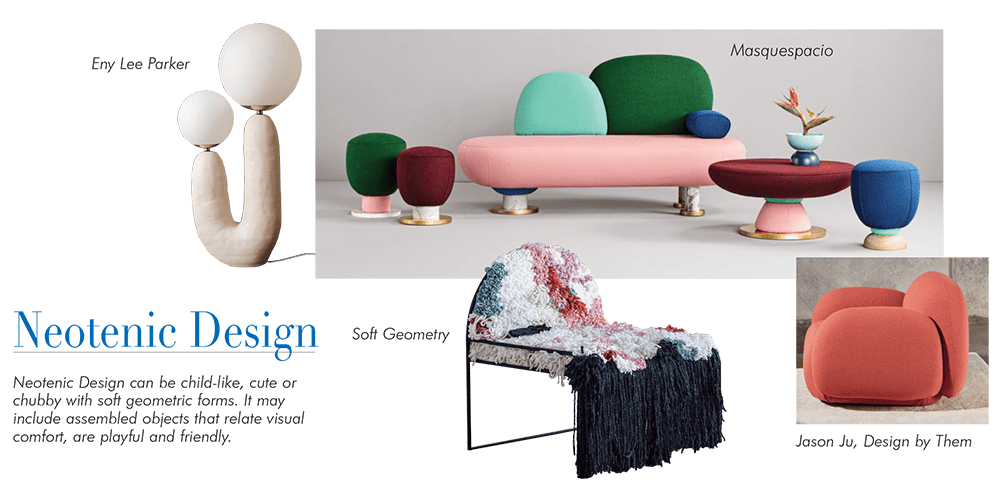
Trend: Art Deco
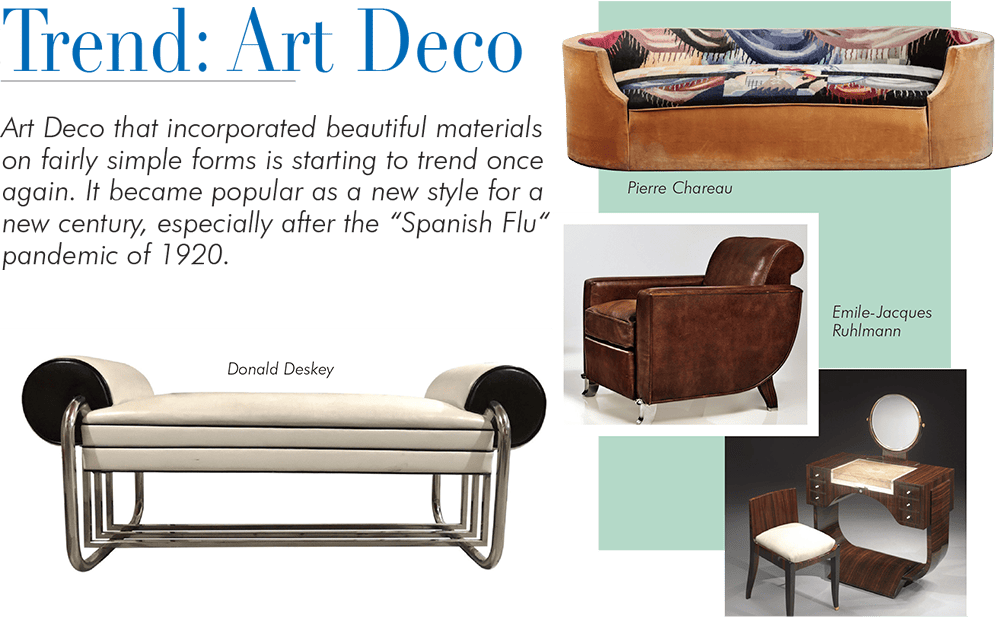
Following the “Spanish Flu” pandemic 100 years ago people went wild during the Roaring 20s. Furniture World asked Sheila Edwards if we might see a similar social movement and perhaps a trend toward more luxurious designs when the current pandemic winds down.
“We’re already seeing a lot of Art Deco, a style that originated in the 1920s. But it’s too early to tell if it’s a centennial proto habit that’s re-emerged or if the market is anticipating the end of the pandemic and a revival of living it up after difficult times.”
Edwards says that “some of the large, rounded, radiused forms and oversized channel tufting that’s trending right now has a strong connection with Art Deco designs.
“Art Deco was created as a new style for a new century—an inter-war style. It was a variant of what the modernists were doing in terms of architecture and interior design at the time, and yet it had elements of luxury that weren’t seen in the Bauhaus approach. Art Deco incorporated beautiful materials on fairly simple forms. The designer Jean-Michel Frank emphasized this idea of simplicity of form combined with the richness of the material.
“If we think of Art Deco as 'future facing luxury' I think this trend will continue, but what millennials consider luxury is perhaps different from the past. I see this new luxe as related to the provenance of materials, craft and a good story.”
Trend: Focus on Finishes
According to Fred Spector, as wood has become more expensive, finishes have become much more important. “It used to be that designers could specify the use of solid Walnut, for example, but for most applications today it’s not possible due to the cost. That's a reason that brands have moved away from producing the pure traditional furniture designs we used to see in our industry,” he explained. “As finishes have become better, designers have pared down ornamentation and emphasized layered finishes. It’s easier and more cost-effective.
“We are seeing larger retailers asking designers to create furniture that includes more texture and eye-catching patterns. Drawer fronts that would typically have been carved or solid wood are being cast in resin material then finished to look like wood. This can be done affordably in a way that consumers can't tell the difference.
Spector believes that some of these shifts away from traditional sold wood designs are being driven by consumer lifestyle changes as well. “Most people don’t need a super formal dining room in addition to an eat-in kitchen. They are looking for furniture that does it all. The classic, formal solid Cherry dining room set our parents or grandparents had, just doesn't fit in with today’s lifestyles.”
Trend: Modern
“Mid-century modern and Scandinavian designs, with their honesty and simplicity, are going to remain popular,” observed Spector. At the most recent High Point October show, these designs were all over Interhall.
“On the manufacturing side, mid-century designs have largely been produced successfully by boutique companies. Larger manufacturers have chosen to trickle mid-century modern design into their lines in a subtle way. Right now designers are seeing more interest in modern designs from larger furniture manufacturers -- even those who wouldn’t typically touch modern styles. They want to introduce it with mixed media and metal elements. Combinations of metal and wood, or metal, wood and woven to marry different patterns, materials and textures.”
Trend: Home Office
Spector also predicts that there will soon be big innovations in home office design. “During the pandemic, the need for a home office expanded rapidly. Developing a new line of furniture can take a year, and we are still dealing with supply chain problems. The industry is just starting to realize that we need to address a new set of home office needs. Businesses have moved away from office cubicles and toward open office plans. I think we’ll see a lot of that move into the home. West Elm has a contract division that can be purchased through Steelcase. Blu Dot has a similar arrangement. We will continue to see a trend toward meshing of residential and contract home office furniture design and production.”
Trend: Storage
We’re seeing cute,
sort of chubby furniture incorporating larger shapes and forms.
This trend might be a reaction to the high level of stress and anxiety present in society. |
“There is an ongoing opportunity,” he believes “for innovation in storage and organization. There are lots of wasted spaces in most sofa designs and under beds.” Spector says that people need storage that will accommodate new technology and adapt to changing needs to house all their stuff.
Trend: Arts & Crafts
“The furniture buying public,” Spector continued, “is looking for more connection to handmade objects. Amish companies that might have previously been on the fringe of the furniture industry have become more important. Major industry players have noticed this trend. The connection to craft and handmade has been around as a trend for a while and that is going to continue in a way that will become more interesting. Retailers such as Crate and Barrel and Restoration Hardware already have spots on their websites where they talk about local craft and are incorporating items into their product mix.
“There are other companies as well that are focusing on introducing furniture with a handcrafted feel including Ethan Allen and McKinnon and Harris, a producer of high-end, hand-crafted outdoor furniture.
“Jay Anna Mize and Gary Inman recently spoke to a group of SCAD students about how craft is coming to the market. I recall that Mize spoke about how Norwalk Furniture introduced fabrics designed by Jill Seale. Mize said that Seale's technique, based on ancient Italian paper marbling brought a regional craft look and story to these upholstered fabric designs.
“International craft techniques are playing a larger role as well. We are seeing handmade ceramics that had become much less important come back in a big way as part of the handmade trend.”
Sheila Edwards agreed that craft looks have become more important. “SCAD students feel a real kinship with William Morris and the Arts & Crafts movement of the late 19th and early 20th century that called into question the social and manufacturing structures of the industrial revolution with an emphasis on craft.
“Today we are seeing the rise of companies like Etsy (etsy.com). Their products reflect the craft movement—a desire for authenticity, and for the author of the work to be known.
“Furnishings purchasers want to hear a craft story and a production story attached to furniture collections, making furniture more exciting and accessible to retail customers.”
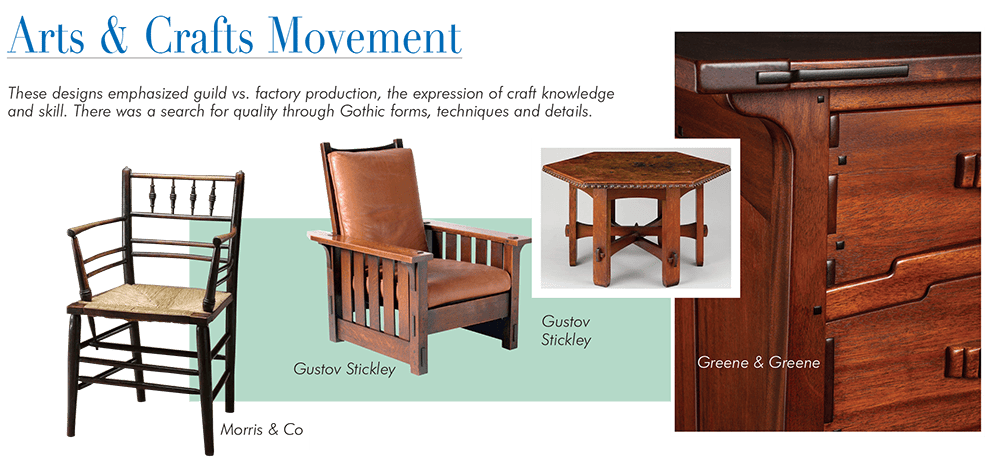
Trend: Neo-Classic

Pictured above are designs created by SCAD students: Walnut Chair by Matthew Grello, Pucker up stools by Lin Zhu, Girl talk chair frame by Suthinee Kasemsomporn and the Cygnus chair by Shih Wu.
|
“Interestingly, there has been a revival of American forms.” Edwards sees more Windsor chairs, trestle tables and Americana furnishings forms emerging. “We’re having an interesting relationship with neo-classicism right now. The classics never really go out of style. And, this trend is a very clear and identifiable indicator that people find comfort in the familiarity of classical forms.”
Form and Function
Henry Sullivan, the modernist architect said, “Whether it be the sweeping eagle in his flight, or the open apple-blossom, the toiling workhorse, the blithe swan, the branching oak, the winding stream at its base, the drifting clouds, over all the coursing sun, form ever follows function, and this is the law. Where function does not change form does not change. The granite rocks, the ever-brooding hills, remain for ages; the lightning lives, comes into shape, and dies in a twinkling.”
Regarding form and function, Sheila offered her view that the basic function of a furniture item “must come first, with the dressing of that function being a secondary consideration. Furniture also satisfies social and emotional needs,” she added. “A kind of functionality as well that goes beyond the basic need for a place to sit, sleep or eat.”
She directed Furniture World readers to the works of two writers, Donald Norman, author of “Emotional Design: Why We Love or Hate Everyday Things,” and Mihaly Csikszentmihalyi's article, “Why We Need Things” that tracks the meaning of objects in our homes. These are both good sources for understanding the motivations consumers have for their home furnishings purchases.
“The pandemic,” Edwards observed, “has led to new ways we are using our homes. I’ve seen a number of really ingenious and hilarious home setups to accommodate working, learning, and children. We’ve seen a sharp rise in the need for practical solutions. It will be interesting to see the residual effects on the balance of function and practicality moving forward.”
Next-Gen Design
“SCAD students are interested in designing objects that meet the emotional, social and functional needs of individuals and society,” observed Professor Edwards. “They see that as a path to sustainability and living a life with meaning.
“That's why attending the High Point Market is often an eye-opening experience for them. The enormity of the industry from brands to manufacturers, buyers to designers, international trade to domestic production; students suddenly recognize how much work (and opportunity) it is to get their idea from paper to the customer's home… and then passed on to subsequent generations.
“At typical furniture stores, there is sometimes a disconnect between what younger consumers say they want and what they’re able to get. Many of our students here at SCAD are trying to fill that void. They can afford IKEA, but they want something that will make a more personal connection and that they will want to keep beyond their next move.
“That’s why many furniture design students choose to design furniture that is ready-to-assemble and easily transported but with higher quality materials and craft details—non-disposable, portable, multi-functional and affordable.”
Furniture Design Programs
In closing, Fred Spector spoke about career prospects for students in furniture design programs. “Thousands of colleges across the country teach interior design, but for those who want to learn how to be a furniture designer, there are only a few schools that teach true furniture design like SCAD does. There are a lot of furniture companies out there that need design help and not a lot of schools teaching furnishings design,” he told Furniture World.
SCAD students enter the workforce well prepared. They are exposed to the best technology as well as the most interesting and intimate part of the craft. They learn the business side of furniture design and do a lot of research. Though some of our students go on to be 'makers' after graduation, most pursue careers as furniture designers. The fact that they’ve spent time in the wood shop, in the metal shop, understand fabrication and the craft of furniture-making, is a real benefit.
Russell Bienenstock is Editor-in-Chief of Furniture World Magazine, founded 1870. Comments can be directed to him at editor@furninfo.com.